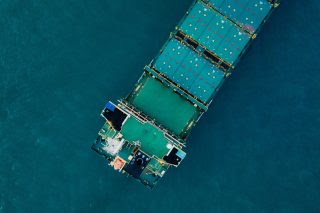The International Maritime Organization (IMO) has issued a new set
of free-of-charge toolkits to assess and address emissions from ships and
ports.
of free-of-charge toolkits to assess and address emissions from ships and
ports.
As explained, the toolkits would help support countries seeking to
develop and strengthen national policy and regulatory frameworks related to the
prevention of air pollution and the reduction of greenhouse gas emissions from
ships.
develop and strengthen national policy and regulatory frameworks related to the
prevention of air pollution and the reduction of greenhouse gas emissions from
ships.
The Ship Emissions Toolkit and Port Emissions Toolkit have been
developed under the GEF-UNDP-IMO Global Maritime Energy Efficiency Partnerships
(GloMEEP) Project, in collaboration with its strategic partners, the Institute
of Marine Engineering, Science and Technology (IMarEST) and the International
Association of Ports and Harbors (IAPH).
developed under the GEF-UNDP-IMO Global Maritime Energy Efficiency Partnerships
(GloMEEP) Project, in collaboration with its strategic partners, the Institute
of Marine Engineering, Science and Technology (IMarEST) and the International
Association of Ports and Harbors (IAPH).
“Both the ship and port emission toolkits provide practical guidance on
assessing emissions so that a national emission reduction strategy for the
maritime sector can be developed. The GloMEEP guides provide a wealth of
information on assessment techniques and how to develop a national strategy, as
well as links to further practical guidance,” Astrid
Dispert, GloMEEP Technical Adviser, said.
assessing emissions so that a national emission reduction strategy for the
maritime sector can be developed. The GloMEEP guides provide a wealth of
information on assessment techniques and how to develop a national strategy, as
well as links to further practical guidance,” Astrid
Dispert, GloMEEP Technical Adviser, said.
Both toolkits — available free to download from the GloMEEP
website — have been developed through extensive testing and feedback from
practical use of the toolkit guides during national and regional training
activities held in the 10 lead pilot countries participating in the GloMEEP
project.
website — have been developed through extensive testing and feedback from
practical use of the toolkit guides during national and regional training
activities held in the 10 lead pilot countries participating in the GloMEEP
project.
“Ports and shipping are intrinsically linked – as such, efforts to
reduce maritime emissions need to extend beyond seagoing ships alone. IMO’s
MARPOL Annex VI regulations on air pollution and energy efficiency are aimed at
ships, but it is clear that for port emissions to be reduced, national
authorities need to consider emissions from all sources, including cargo
handling equipment, trucks – as well as domestic vessels. By utilising these
guides, countries can develop national strategies which will address emissions
from their maritime sector as a whole – protecting public health and the
environment and contributing to the fight against climate change,” Dispert
added.
reduce maritime emissions need to extend beyond seagoing ships alone. IMO’s
MARPOL Annex VI regulations on air pollution and energy efficiency are aimed at
ships, but it is clear that for port emissions to be reduced, national
authorities need to consider emissions from all sources, including cargo
handling equipment, trucks – as well as domestic vessels. By utilising these
guides, countries can develop national strategies which will address emissions
from their maritime sector as a whole – protecting public health and the
environment and contributing to the fight against climate change,” Dispert
added.
Such strategies would include incorporating IMO regulations into
national legislation. Annex VI of IMO’s International Convention for the
Prevention of Pollution from ships (MARPOL) includes regulations to limit air
pollution from ships as well as energy efficiency regulations to cut greenhouse
gas emissions from ships.
national legislation. Annex VI of IMO’s International Convention for the
Prevention of Pollution from ships (MARPOL) includes regulations to limit air
pollution from ships as well as energy efficiency regulations to cut greenhouse
gas emissions from ships.
In April 2018, IMO adopted its initial IMO strategy on reduction of GHG
emissions from ships, which sets out a vision to reduce GHG emissions from
international shipping and phase them out, as soon as possible in this century.
The initial strategy recognizes the important role of ports as well as shipping
in achieving the ambitious targets.
emissions from ships, which sets out a vision to reduce GHG emissions from
international shipping and phase them out, as soon as possible in this century.
The initial strategy recognizes the important role of ports as well as shipping
in achieving the ambitious targets.
The Ship Emissions Toolkit provides a structured framework, as well as
decision support tools for evaluating emissions reduction opportunities in
maritime transport. It offers guidance to countries seeking to develop and
strengthen national policy and regulatory frameworks related to the prevention
of air pollution and the reduction of GHG emissions from ships.
decision support tools for evaluating emissions reduction opportunities in
maritime transport. It offers guidance to countries seeking to develop and
strengthen national policy and regulatory frameworks related to the prevention
of air pollution and the reduction of GHG emissions from ships.
It not only considers emissions from international shipping but also
encourages the user to assess emissions from and identify emissions reduction
opportunities for the domestic fleet. The toolkit also recognizes that ships
and ports are intrinsically connected and as such also provides links to the
Port Emissions Toolkit.
encourages the user to assess emissions from and identify emissions reduction
opportunities for the domestic fleet. The toolkit also recognizes that ships
and ports are intrinsically connected and as such also provides links to the
Port Emissions Toolkit.
As more attention is focused on reducing emissions from the entire marine
shipping sector, ports are driven to understand the magnitude of the air
emissions impact from their operations on the local and global community and to
develop strategies to reduce this impact. Port emissions inventories provide
the basic building block to the development of a port emissions reduction
strategy.
shipping sector, ports are driven to understand the magnitude of the air
emissions impact from their operations on the local and global community and to
develop strategies to reduce this impact. Port emissions inventories provide
the basic building block to the development of a port emissions reduction
strategy.
World Maritime News.

